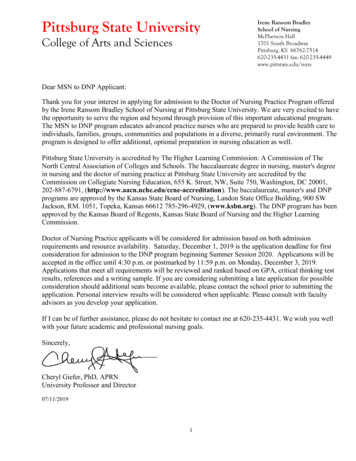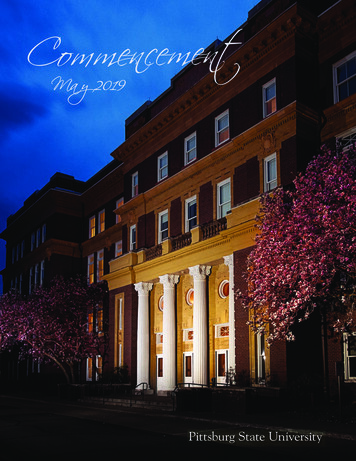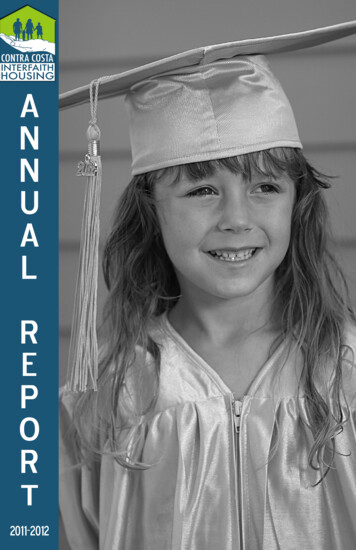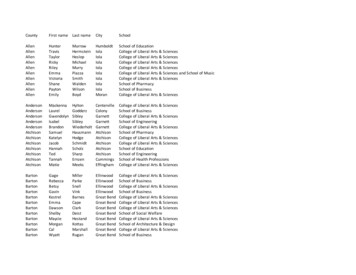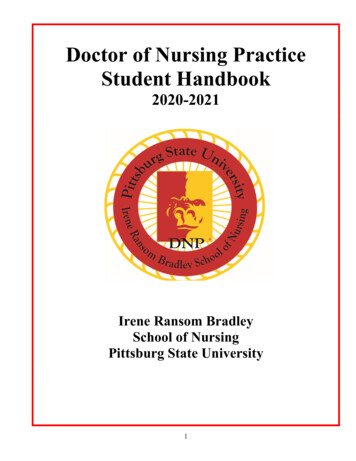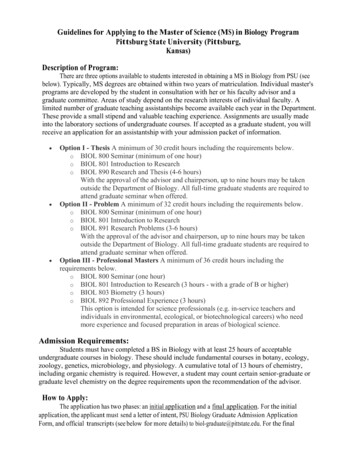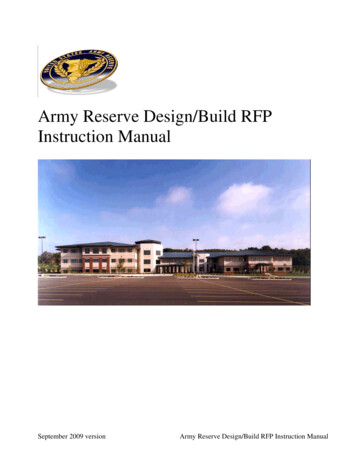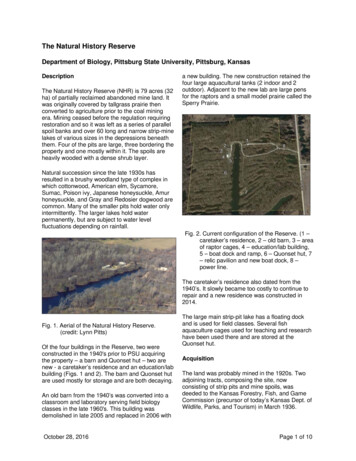
Transcription
The Natural History ReserveDepartment of Biology, Pittsburg State University, Pittsburg, KansasDescriptionThe Natural History Reserve (NHR) is 79 acres (32ha) of partially reclaimed abandoned mine land. Itwas originally covered by tallgrass prairie thenconverted to agriculture prior to the coal miningera. Mining ceased before the regulation requiringrestoration and so it was left as a series of parallelspoil banks and over 60 long and narrow strip-minelakes of various sizes in the depressions beneaththem. Four of the pits are large, three bordering theproperty and one mostly within it. The spoils areheavily wooded with a dense shrub layer.a new building. The new construction retained thefour large aquacultural tanks (2 indoor and 2outdoor). Adjacent to the new lab are large pensfor the raptors and a small model prairie called theSperry Prairie.Natural succession since the late 1930s hasresulted in a brushy woodland type of complex inwhich cottonwood, American elm, Sycamore,Sumac, Poison ivy, Japanese honeysuckle, Amurhoneysuckle, and Gray and Redosier dogwood arecommon. Many of the smaller pits hold water onlyintermittently. The larger lakes hold waterpermanently, but are subject to water levelfluctuations depending on rainfall.Fig. 2. Current configuration of the Reserve. (1 –caretaker’s residence, 2 – old barn, 3 – areaof raptor cages, 4 – education/lab building,5 – boat dock and ramp, 6 – Quonset hut, 7– relic pavilion and new boat dock, 8 –power line.The caretaker’s residence also dated from the1940’s. It slowly became too costly to continue torepair and a new residence was constructed in2014.Fig. 1. Aerial of the Natural History Reserve.(credit: Lynn Pitts)Of the four buildings in the Reserve, two wereconstructed in the 1940's prior to PSU acquiringthe property – a barn and Quonset hut – two arenew - a caretaker’s residence and an education/labbuilding (Figs. 1 and 2). The barn and Quonset hutare used mostly for storage and are both decaying.An old barn from the 1940’s was converted into aclassroom and laboratory serving field biologyclasses in the late 1960's. This building wasdemolished in late 2005 and replaced in 2006 withOctober 28, 2016The large main strip-pit lake has a floating dockand is used for field classes. Several fishaquaculture cages used for teaching and researchhave been used there and are stored at theQuonset hut.AcquisitionThe land was probably mined in the 1920s. Twoadjoining tracts, composing the site, nowconsisting of strip pits and mine spoils, wasdeeded to the Kansas Forestry, Fish, and GameCommission (precursor of today’s Kansas Dept. ofWildlife, Parks, and Tourism) in March 1936.Page 1 of 10
Part of the area was reclaimed as a state CCCproject including some leveling of spoil banks andsome experimental plantings of woody crop plants.In April 1949, the property was transferred to theKansas State Teacher’s College of Pittsburg(precursor of today’s Pittsburg State University). Itwas used in this period as a veteran’s vocationaltraining center in agriculture. Orchard trees weremanaged and some livestock was kept in thewestern side. It was known then as the “CollegeFarm.”The faculty and students of the BiologyDepartment conducted many studies during thattime into the 1950s. In the 1960's, the BiologyDepartment began managing the property as a sitefor research and teaching (Fig. 3).UsageThe Research Reserve has a history of use forresearch, education, and service. An initial aquaticstudy was published in 1953 by Charles C. Burnerand Claude Leist (“A Limnological Study of theCollege Farm Strip-Mine Lake.” Transactions of theKansas Academy of Science. 56:78-85). Manytheses, most recent ones involving fish culture,have been conducted on the site or using the site(see list below).Undergraduate students have also been involvedin research or service projects at the NHR. InSpring 2004, Jamie Horton established a smallprairie plot for the purposes of environmentaleducation. The plot remains today, but has beenre-established at least once.The NHR is also used in undergraduate andgraduate education. Upper division and graduatefield biology classes use the Reserve for classrelated field work. In “Limnology”, the main pit isused for sampling and the lab building as a basefor field water quality analysis. In “Terrestrial FieldEcology” vegetated areas have been used forquantitative vegetation surveys. In “RegionalNatural History” the sites is used for mammal trackand sign collection, bird observation, and plantidentification. The NHR is also used byMammalogy and Ornithology. The site is also usedfor observations of ecology or raptors in the nonmajor biology course “Environmental Life Science”and the mixed-major “General Biology”. Over 400students access the site each year.The NHR also houses a set of outdoor cages forraptors used in the Department’s environmentaleducation program, Nature Reach. Biology majorsalso gain experience (course work or volunteer) inbird husbandry.Fig. 3. An early schematic of the Reserve while itwas used an ag farm by the University.From Sperry (1963).October 28, 2016Many construction and service projects haveoccurred at the Reserve, mostly involvinginfrastructure for the raptor program. Students inthe “Principles of Conservation” class haveperformed service projects for the site. Outsideparties have also contributed to the NHR.Donations of money or in-kind contributions havebeen received from the Sperry-Galligar AudubonSociety, including 2,300 to help construction of anew raptor/lab building. Westar Energy, through itsGreen Team program, has donated materials andlabor to construct cages for non-releasable birds.Page 2 of 10
During the summer, nature camps have been heldfor grade-school age children under the auspicesof Nature Reach. A teaching garden wasdeveloped adjacent to the caretaker home to beused as a part of the camps. In addition, apicnic/teaching area was established to the southof the education/lab building.ManagementThe University provides much of the maintenanceneeded at the site. The primary management ismowing along the road and open areas near thebuildings and road as well as some access trails.In 2011, Westar Energy cut a swath of trees downto protect the power line onto the site.Other activities include annual mowing or burningof Sperry Prairie, herbicide application to controlJohnson grass and Sericea lespedeza, and annualmaintenance of brush near the dock and otheraquatic areasBiodiversityThere are a series of 1960’s vintage inventoriesthat have mostly not been updated (Arruda 2011).The bird list was revised in 1989-1995 by ChrisPistole and there is modern list of terrestrialgastropods. Amphibians, reptiles, mammals andplants have not been revisited.Theses2003. Training White Crappie (Pomoxis annularis)to a Commercial Pellet Using GroundGizzard Shad (Dorosoma cepedianum).Spencer, Amy D. (Advisor: Dr. J.R. Triplett)[used NHR to manage fish for use in study]October 28, 20162002*. Compensatory Feeding and Culture ofBlack Crappie (Pomoxis nigromaculatus) ina Recirculating System. Doolin III, James P.(Advisor: Dr. J.R. Triplett)1995*. Culture of White Crappie (Pomoxisannularis) in a Recirculating System.Thomas, George L. (Advisor: Dr. J.R.Triplett)1994. Cage Culture of Black, White, and F1 HybridCrappie (Pomoxis Species). Read, D.V.M.,Emily R. (Advisor: Dr. J.R. Triplett)1992. Comparisons of Three Feeding Techniquesin the Cage Culture of Ictalurus punctatus.Bussone, Jim J. (Advisor: Dr. J.R. Triplett)1991*. Trainability, Growth, and ConversionEfficiency of White Crappie Pomoxisannularis on an Artificial Diet. Amspacker,Troy D. (Advisor: Dr. J.R. Triplett)1978. The Mammals of the PSU Natural HistoryResearch Reserve. Foutchi, Hossein.(Advisor: Dr. Horace Hays)1977. The Growth Rate of Certain Fishes in aStrip-mine Lake. Renegar, Steven J.(Advisor: Dr. J. Carl Bass)1977. An Ecological Study of the Cottontail Rabbit(Sylvilagus floridanus) at the PSU NaturalResearch Reserve. Racy, Jeffrey L.(Advisor: Dr. Horace Hays)1977. The Diatom Flora of Two Strip-mine Lakeson the PSU Natural History Reserve. Frank,Jann P. (Advisor: Dr. Eugene Fairchild)1972. Growth-Rate Analysis of Members of aCentrarchid Community in a Strip-mineLake. Meyer, Robert E. (Advisor: Dr. J. CarlBass)1972. A Taxonomic Study of the Yeasts Isolatedfrom Orchard Soil on the Natural HistoryResearch Reserve of Kansas State Collegeof Pittsburg. Byler, Donna I. (Advisor: Dr.Bettie Duncan)1971. Age and Growth of Three Species ofCentrachids from a Natural HistoryResearch Reserve Strip-mine Lake andComparison with Growth Rates Attained inSimilar Lakes. Reed, Mildred A. (Advisor:Dr. J. Carl Bass)1970. An Analysis of the Age and Growth Rates ofA Lepomis cyanellus Population Taken froma Strip-mine Lake in Southeast Kansas.Rudella, John D. (Advisor: Dr. J. Carl Bass)1970. Age and Growth of a Population of Bluegill.Coffey, Roger L. (Advisor: Dr. J. Carl Bass)1968. The Osteogenesis of the Pectoral Spine ofthe Channel Catfish Ictalurus punctatus(Rafinesque). Triplett, James Robert.(Advisor: Dr. J. Carl Bass)Page 3 of 10
1967. A Growth Comparison of the BluegillLepomis macrochirus in a Pennsylvania anda Kansas Strip-mine Lake. Wessner, John.(Advisor: Dr. J. Carl Bass)1965. Some Aspects of the Ecology of SmallRodents in a Strip-mine Habitat. Heacock,Kenneth L. (Advisor: Dr. Horace Hays)1965. Comparison of Growth Rate of Pomixisannularis in Two Strip Pits in CrawfordCounty Kansas. Alexander, Ronald R.(Advisor: Dr. J. Carl Bass)1951. Fish Production in Strip-mine Lakes ofSoutheastern Kansas: II. A PreliminaryLimnological Study of the College FarmStrip-mine Lake. Burner, Charles G.(Advisor: Dr. C. Leist)Publications1992. Ford, Steven. PSU Natural History Reserve.pp. 9-12 in: J. Arruda (ed), Kansas Academy ofScience Multidisciplinary Guidebook 6. FallField Trip to the Natural Areas of SoutheastKansas. Kansas Geological Survey Open-FileReport 92-22. 91 pp.1983. Briggs, John M., Jeffrey L. Racey, andHorace A. Hays. A five-year study (1975-1979)of the home range of the Cottontail Rabbit[Sylvilagus floridanus alacer (Bangs)] on stripmined land in southeast Kansas. Transactionsof the Kansas Academy of Science. 86(1):2430.1963. Sperry, Theodore M. The Natural HistoryResearch Reserve of the Kansas StateCollege of Pittsburg. Transactions of theKansas Academy of Science. 66(1):76-81.1954. Maupin, James K., James R. Wells, Jr., andClaude Leist. A preliminary survey of the foodOctober 28, 2016habits of the fish and physico-chemicalconditions of the water of three strip-minelakes. Transactions of the Kansas Academy ofScience. 57(2):164-171.1953. Burner, Charles C. and Claude Leist. Alimnological study of the college farm stripminelake. Transactions of the Kansas Academy ofScience. 56(1):78-85.1953. Wells, James R. The reclamation of stripmined areas in southeastern Kansas.Transactions of the Kansas Academy ofScience. 56(3):296-292.1952*. Burner, Charles C. and Claude Leist.Studies in strip-mine lake improvement.Kansas Forestry, Fish, and GameCommission, Bull. 9:2-4.1951*. Rogers, Nelson F. Strip-mined lands of theWestern Interior Coal Province. ResearchBulletin 475, Agr. Exp. Stud., Univ. of Mo.,Columbia, Mo.1949*. Rogers, Nelson F. The growth anddevelopment of Black Walnut (Juglans nigraL.) on coal strip-mined land in southeastKansas. Transactions of the Kansas Academyof Science. 52:99-104.* thesis or publication related the theme of the fieldsites, but did not use the siteDepartmental Documents2016. Arruda, J. Biodiversity of the Natural HistoryReservations. Southeast Kansas BiologicalStation. Department of Biology, Pittsburg StateUniversity, Pittsburg, Kansas. pp 7.Page 4 of 10
Image by Horace Hays (1958), probably the north end of the main strip-pit lakeSource unknown, ca 1960s, view looking east-northeastOctober 28, 2016Page 5 of 10
Source unknown, ca 1960s, view looking south-southwestSource unknown, ca 1960s, view looking east-northeastOctober 28, 2016Page 6 of 10
Demolition of the old lab building (October-November 2006).Walls of new education/lab building made with “ecoblocks” (November 2006).October 28, 2016Page 7 of 10
Completed education/lab building (summer 2007).View across main strip-pit lake toward education/lab building and barn (spring 2007).October 28, 2016Page 8 of 10
Finishing stages of the caretaker’s residence (February 2014)View across main strip-pit lake toward new residence (February 2014).October 28, 2016Page 9 of 10
The dock at the main pit (November 2014).A view looking south down the main pit (November 2014).October 28, 2016Page 10 of 10
the property - a barn and Quonset hut - two are new - a caretaker's residence and an education/lab building (Figs. 1 and 2). The barn and Quonset hut are used mostly for storage and are both decaying. An old barn from the 1940's was converted into a classroom and laboratory serving field biology classes in the late 1960's. This building was




